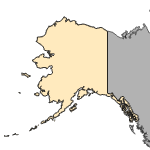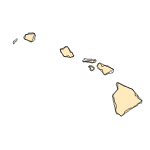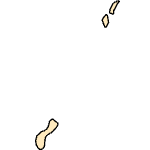Dryophytes gratiosus
(Barking Treefrog)
Amphibians-Frogs
Native Transplant |
|
Common name: Barking Treefrog
Taxonomy: available through
www.itis.gov
Identification: Dryophytes gratiosus is one of the larger, stouter treefrogs indigenous to North America, with an adult SVL (snout-vent length) of 51-70 mm (2-2.75 in) (Conant and Collins, 1998). Despite their ability to change color from brown, to gray, yellow, or various shades of green, they often have dark round spots dorsally, that may persist through some of these changes (Wright and Wright, 1949; Conant and Collins, 1998). Unlike Dryophytes cinereus, the green treefrog, a light streak, if present on the upper lip, is typically sharply defined, and the skin is somewhat granular (Powell et al., 1998). Like many hylids (treefrogs), toepads (disks) for climbing are present (Conant and Collins, 1998; Powell et al., 1998). This frog's name is derived from its call which is nine or ten syllables of raucous barking, or a single explosive "doonk" or "toonk" sometimes repeated at intervals of one or two seconds; much louder and deeper than D. cinereus (Wright and Wright, 1949; Ashton and Ashton, 1988; Bogert, 1998; Conant and Collins, 1998). Recording of these calls have been made available on CDs (Elliott, 1994; Library of Natural Sounds, 1996; Bogert, 1998). Barking treefrogs have the largest tadpoles of any indigenous hylid, up to 50 mm (2 in) or more in length; they are a colorful green or greenish-yellow, with a dark saddle on the muscular part of the tail (missing in larger individuals), orange or yellow-green on the large upper fin and muscular part of the tail, a light line from eye to vent, and a pale pink venter (belly) (Wright and Wright, 1949; Ashton and Ashton, 1988; Dundee and Rossman, 1989). Identification can be made confusing by the fact that barking treefrogs occasionally hybridize with Dryophytes cinereus; the resulting hybrids exhibit an intermediate suite of characteristics (Dundee and Rossman, 1989; Bogert, 1998; Conant and Collins, 1998). See the species account titled "Hyla cinerea (Schneider, 1799)" on this website.
Barking treefrogs have been illustrated by a variety of authors (Wright and Wright, 1949; Mount, 1975; Ashton, 1978; Smith, 1978; Behler and King, 1979; Martof et al., 1980; Mattison, 1987; Ashton and Ashton, 1988; Dundee and Rossman, 1989; Carmichael and Williams, 1991; Lamar, 1997; Bogert, 1998; Conant and Collins, 1998; Powell et al., 1998; Bartlett and Bartlett, 1999).
Size: snout-vent length of 51-70 mm
Native Range: The indigenous range of barking treefrogs includes southern portions of the Coastal Plains states of Alabama, Georgia, South Carolina, southeastern North Carolina, the Florida Parishes of Louisiana, extreme southern Tennessee, and most of Florida except for the Keys and the extreme southern tip of the peninsula (Martof, 1956; Lee, 1969; Mount, 1975; Behler and King, 1979, Stevenson, 1976; Martof et al., 1980; Caldwell, 1982; Lohoefener and Altig, 1983; Ashton and Ashton, 1988; Moler, 1988; Dundee and Rossman, 1989; Carmichael and Williams, 1991; Gibbons and Semlitsch, 1991; Conant and Collins, 1998; Bartlett and Bartlett, 1999; Duellman and Sweet, 1999; King, 2000). Disjunct populations occur in eastern Maryland and adjacent Delaware, southeastern Virginia, and on the border of north-central Tennessee and southern Kentucky (Tobey, 1985; Conant and Collins, 1980).



|

Alaska |

Hawaii |

Puerto Rico &
Virgin Islands |

Guam Saipan |
Hydrologic Unit Codes (HUCs) Explained
Interactive maps: Point Distribution Maps
Nonindigenous Occurrences:
Table 1. States with nonindigenous occurrences, the earliest and latest observations in each state, and the tally and names of HUCs with observations†. Names and dates are hyperlinked to their relevant specimen records. The list of references for all nonindigenous occurrences of Dryophytes gratiosus are found here.
Table last updated 12/4/2025
† Populations may not be currently present.
Means of Introduction: This previously undiscovered population of barking treefrogs was located in an area that had been intensively surveyed in past years (Black and Gosner, 1958). Their sudden appearance is a mystery (Black and Gosner, 1958).
Status: For several years (more than a decade?) H. gratiosa formed an established breeding population in Cape May County, New Jersey (Black and Gosner, 1958; Conant, 1958, 1975; Smith and Kohler, 1978), but they currently seem to be extirpated (Gosner in Caldwell, 1982; Conant and Collins, 1998) and are not listed by Schwartz and Golden (2002).
Impact of Introduction: The impact of barking treefrogs upon New Jersey wildlife is unknown, and probably will never be determined now that they are extirpated. It is possible that adults and tadpoles may have briefly impacted frogs indigenous to this area.
References: (click for full references)
Ashton, R. E., Jr. 1978. Identification manual to the amphibians and reptiles of Florida. Florida State Museum Associates, University of Florida, Interpretation Series (1):[1-41].
Ashton, R. E., Jr., and P. S. Ashton. 1988. Handbook of Reptiles and Amphibians of Florida. Part Three. The Amphibians. Windward Publishing, Inc., Miami. 191 pp.
Bartlett, R. D., and P. P. Bartlett. 1999. A Field Guide to Florida Reptiles and Amphibians. Gulf Publishing Company, Houston. 280 pp.
Behler, J. L., and F. W. King. 1979. The Audubon Society Field Guide to North American Reptiles and Amphibians. Alfred A. Knopf, Inc., New York. 743 pp.
Black, I. H., and K. L. Gosner. 1958. The barking tree frog, Hyla gratiosa, in New Jersey. Herpetologica 13(4):254-255.
Bogert, C. M. 1998. Sounds of North American Frogs. The Biological Significance of Voice in Frogs. Smithsonian Folkways Recordings, Washington, D.C. Audio CD Recording.
Caldwell, J. P. 1982. Hyla gratiosa. Catalogue of American Amphibians and Reptiles (298):1-2.
Carmichael, P., and W. Williams. 1991. Florida's Fabulous Reptiles and Amphibians. World Publications, Tampa. 120 pp.
Collins, J. T., and T. W. Taggart. 2002. Standard Common and Current Scientific Names for North American Amphibians, Turtles, Reptiles & Crocodilians. Fifth Edition. The Center for North American Herpetology, Lawrence, Kansas. 44 pp.
Conant, R. 1958. A Field Guide to Reptiles and Amphibians of the United States and Canada East of the 100th Meridian. Houghton Mifflin Company, Boston. 366 pp.
Conant, R. 1975. A Field Guide to Reptiles and Amphibians of Eastern and Central North America. Second Edition. Houghton Mifflin Company, Boston. 429 pp.
Conant, R., and J. T. Collins. 1998. A Field Guide to Reptiles & Amphibians. Eastern and Central North America. Third Edition, Expanded. Houghton Mifflin Company, Boston. 616 pp.
Conant, R., and J.T. Collins. 1991. A field guide to reptiles and amphibians of eastern and central North America. Volume 12. Houghton Mifflin Co, Boston, MA.
Crother, B. I., J. Boundy, J. A. Campbell, K. de Quieroz, D. Frost, D. M. Green, R. Highton, J. B. Iverson, R. W. McDiarmid, P. A. Meylan, T. W. Reeder, M. E. Seidel, J. W. Sites, Jr., S. G. Tilley, and D. B. Wake. 2003. Scientific and standard English names of amphibians and reptiles of North America north of Mexico: Update. Herpetological Review 34(3):196-203.
Crother, B.I. (chair). Committee on Standard and English and Scientific Names. 2008. Scientific and standard English names of amphibians and reptiles of North America north of Mexico, with comments regarding confidence in our understanding. Society for the Study of Amphibians and Reptiles Herpetological Circular. No. 37. iii + 86p.
Duellman, W. E., and S. S. Sweet. 1999. Distribution patterns of amphibians in the Nearctic Region of North America. Pp. 31-109. In: W. E. Duellman (editor). Patterns of Distribution of Amphibians. A Global Perspective. The Johns Hopkins University Press, Baltimore. 633 pp.
Dundee, H. A., and D. A. Rossman. 1989. The Amphibians and Reptiles of Louisiana. Louisiana State University Press, Baton Rouge and London. 300 pp + unattached erratum.
Elliott, L. 1994. The Calls of Frogs and Toads. NatureSound Studio, NorthWood Press, Inc., Minocqua, Wisconsin. Audio CD Recording.
Frost, D. R. (editor). 1985. Amphibian Species of the World. A Taxonomic and Geographical Reference. Allen Press, Inc. and The Association of Systematics Collections. Lawrence, Kansas. 732 pp.
Frost, D. [R.] (compiler). 2000. Anura�—frogs. Pp. 6-17. In: B. I. Crother (chair), and Committee on Standard English and Scientific Names (editors). Scientific and standard English names of amphibians and reptiles of North America north of Mexico, with comments regarding confidence in our understanding. Society for the Study of Amphibians and Reptiles Herpetological Circular (29):i-iii, 1-82.
Gibbons, J. W., and R. D. Semlitsch. 1991. Guide to the Reptiles and Amphibians of the Savannah River Site. The University of Georgia Press, Athens, Georgia, and London. 131 pp.
King, F. W. 2000. Florida Museum of Natural History's Checklist of Florida Amphibians and Reptiles [online]. Available on URL: http://www.flmnh.ufl.edu/herps/FL-GUIDE/Flaherps.htm. Florida Museum of Natural History, University of Florida, Gainesville.
Lamar, W. W. 1997. The World's Most Spectacular Reptiles & Amphibians. World Publications, Tampa. 210 pp.
Lee, D. S. 1969. The treefrogs of Florida. Florida Naturalist 42(3):117-120.
Library of Natural Sounds. 1996. Voices of the Night. The Calls of the Frogs and Toads of Eastern North America. Cornell Laboratory of Ornithology, Ithaca. Audio CD Recording.
Lohoefener, R., and R. Altig. 1983. Mississippi herpetology. Mississippi State University Research Center Bulletin (1):i-vi, 1-66.
Martof, B. S. 1956. Amphibians and Reptiles of Georgia. University of Georgia Press, Athens, Georgia. 94 pp.
Martof, B. S., W. M. Palmer, J. R. Bailey, and J. R. Harrison III. 1980. Amphibians and Reptiles of the Carolinas and Virginia. The University of North Carolina Press, Chapel Hill. 264 pp.
Mattison, C. 1987. Frogs & Toads of the World. Facts on File, Inc, New York. 191 pp.
Moler, P. 1988. A Checklist of Florida's Amphibians and Reptiles. Nongame Wildlife Program, Florida Game and Fresh Water Fish Commission, Tallahassee. 18 pp.
Mount, R. H. 1975. The Reptiles and Amphibians of Alabama. Auburn University Agricultural Experiment Station, Auburn. 347 pp.
Murphy, C. G., P. W. Sherman, and S. T. Emlen. 1993. Reproductive Strategies of the Treefrog Hyla gratiosa: Implications for Management. Nongame Wildlife Program Final Report, Project NG88-020, Florida Game and Fresh Water Fish Commission, Tallahassee. 57 pp.
Powell, R., J. T. Collins, and E. D. Hooper, Jr. 1998. A Key to Amphibians & Reptiles of the Continental United States and Canada. University Press of Kansas, Lawrence. 131 pp.
Schwartz, V., and D. M. Golden. 2002. Field Guide to Reptiles and Amphibians of New Jersey. New Jersey Division of Fish & Wildlife, Endangered & Nongame Species Program, [Trenton].
Smith, H. M. 1978. A Guide to Field Identification. Amphibians of North America. Golden Press, New York. 160 pp.
Smith, H. M., and A. J. Kohler. 1978. A survey of herpetological introductions in the United States and Canada. Transactions of the Kansas Academy of Science 1977 80(1-2):1-24.
Stevenson, H. S. 1976. Vertebrates of Florida. Identification and Distribution. University Presses of Florida, Gainesville. 607 pp.
Tobey, F. J. 1985. Virginia's Amphibians and Reptiles: A Distributional Survey. Virginia Herpetological Society, Richmond and Purcellville. 114 pp.
Wright, A. H., and A. A. Wright. 1949. Handbook of Frogs and Toads of the United States and Canada. Third Edition. Cornell University Press, Ithaca and London. 640 pp.
Author:
Somma, L.A.
Revision Date: 5/6/2021
Citation Information:
Somma, L.A., 2025, Dryophytes gratiosus (LeConte, 1856): U.S. Geological Survey, Nonindigenous Aquatic Species Database, Gainesville, FL, https://nas.er.usgs.gov/queries/factsheet.aspx?SpeciesID=55, Revision Date: 5/6/2021, Access Date: 12/5/2025
This information is preliminary or provisional and is subject to revision. It is being provided to meet the need for timely best science. The information has not received final approval by the U.S. Geological Survey (USGS) and is provided on the condition that neither the USGS nor the U.S. Government shall be held liable for any damages resulting from the authorized or unauthorized use of the information.